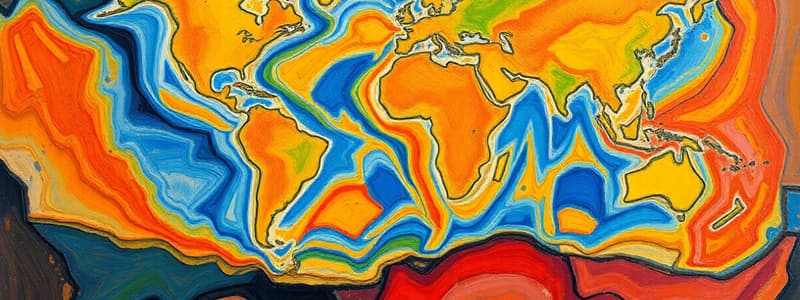Podcast
Questions and Answers
Which of the following is NOT an erosional feature created by sea waves?
Which of the following is NOT an erosional feature created by sea waves?
- Sea cliffs
- Stacks
- Sea caves
- Beaches (correct)
What primarily causes the formation of ox bow lakes?
What primarily causes the formation of ox bow lakes?
- Movements of tectonic plates
- Meandering rivers (correct)
- Sediment deposition
- Erosion by glaciers
Which feature is associated with the sudden movements of the earth?
Which feature is associated with the sudden movements of the earth?
- Mushroom rock
- Flood plain
- Sand dune
- Earthquake (correct)
What is the primary reason why flood plains are considered very fertile?
What is the primary reason why flood plains are considered very fertile?
Which feature represents a depositional structure formed by glaciers?
Which feature represents a depositional structure formed by glaciers?
Flashcards
What causes earthquakes?
What causes earthquakes?
The movement of Earth's tectonic plates causes earthquakes. These plates are constantly shifting due to the heat within the Earth's core, which drives convection currents in the mantle.
What is erosion?
What is erosion?
Erosion is the process of wearing away and transporting rock and soil by natural forces like wind, water, and ice. It shapes the Earth's surface over time.
How are flood plains formed?
How are flood plains formed?
A flood plain is a flat, fertile area of land beside a river. It's formed by the deposition of sediment during floods.
What are sand dunes?
What are sand dunes?
Signup and view all the flashcards
How are beaches formed?
How are beaches formed?
Signup and view all the flashcards
Study Notes
Lithospheric Plates
- The lithosphere is divided into numerous plates called lithospheric plates
- These plates move slowly, a few millimeters per year
- This movement is due to the movement of molten magma within the Earth
- The movement of these plates causes changes on Earth's surface
Endogenic Forces
- Forces acting within the Earth's interior
- Include earthquakes and volcanoes
- Earthquakes cause sudden movements, and volcanoes cause mass destruction
Exogenic Forces
- Forces working on Earth's surface
- Examples include erosion and weathering
- They are responsible for the continuous wearing away of landscapes
Volcanoes
- A volcano is an opening in the Earth's crust where molten material erupts
- Molten material is called magma, and gases and ash are also released
Earthquakes
- Vibrations that travel all around the Earth
- The place where the movement starts is the focus
- The place on the surface above the focus is the epicentre
- Earthquakes are measured using a seismograph on the Richter scale
Weathering
- The breaking down of rocks on the Earth's surface
- This occurs due to different agents, like water, wind, and ice
Erosion
- The wearing away of the landscape
- Eroded material is carried by water, wind, or ice
River Work
- Rivers erode landscapes and create different landforms
- Meanders form when rivers twist and turn, and cut-off lakes (oxbow lakes) form
- Waterfalls and erosion features depend on the hardness of the rocks
Sea Waves
- Coastal landforms arise from the erosion and deposition of sea waves
- Sea caves, stacks, and arches are formed by waves striking the rocks
- The sea waves deposit sediments along the coast, creating beaches
Work of Ice
- Glaciers erode landscapes by carrying and depositing sediments
- These deposited sediments are called glacial moraines.
Work of Wind
- Wind is an erosional agent in deserts
- Wind erosion creates different features such as mushroom rocks and sand dunes
- Wind deposits in large areas is called loess
Landforms
- Landforms are shapes of the Earth's surface that result from forces at work on the Earth's crust
- Different processes create different landforms, like rivers, glaciers, sea, and wind
Studying That Suits You
Use AI to generate personalized quizzes and flashcards to suit your learning preferences.
Related Documents
Description
Explore the dynamics of lithospheric plates and the forces that shape our planet. This quiz covers both endogenic forces like earthquakes and volcanoes, and exogenic forces such as erosion and weathering. Test your knowledge about Earth's internal and surface processes.




